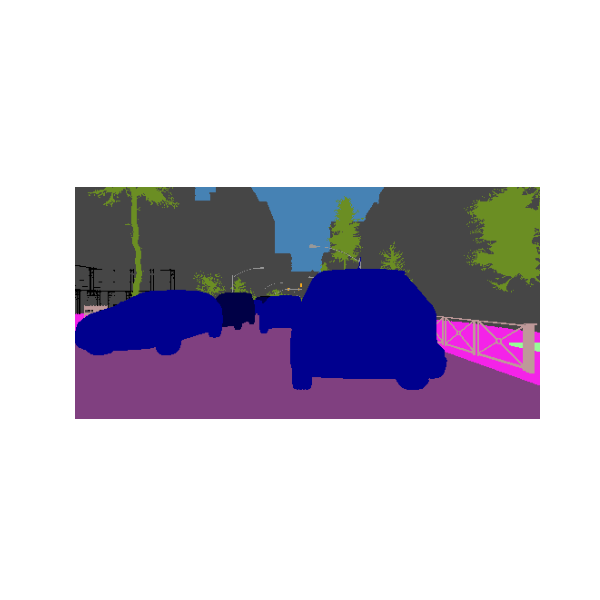Note
Go to the end to download the full example code.
Monte Carlo Dropout for Semantic Segmentation on MUAD#
This tutorial demonstrates how to train a segmentation model on the MUAD dataset using TorchUncertainty. MUAD is a synthetic dataset designed for evaluating autonomous driving under diverse uncertainties. It includes 10,413 images across training, validation, and test sets, featuring adverse weather, lighting conditions, and out-of-distribution (OOD) objects. The dataset supports tasks like semantic segmentation, depth estimation, and object detection.
For details and access, visit the MUAD Website.
1. Loading the utilities#
First, we load the following utilities from TorchUncertainty:
the TUTrainer which mostly handles the link with the hardware (accelerators, precision, etc)
the segmentation training & evaluation routine from torch_uncertainty.routines
the datamodule handling dataloaders: MUADDataModule from torch_uncertainty.datamodules
the model: small_unet from torch_uncertainty.models.segmentation.unet
the MC Dropout wrapper from torch_uncertainty.models
import matplotlib.pyplot as plt
import torch
import torchvision.transforms.v2.functional as F
from huggingface_hub import hf_hub_download
from torch import optim
from torch.optim import lr_scheduler
from torchvision import tv_tensors
from torchvision.transforms import v2
from torchvision.utils import draw_segmentation_masks
from torch_uncertainty import TUTrainer
from torch_uncertainty.datamodules.segmentation import MUADDataModule
from torch_uncertainty.models import mc_dropout
from torch_uncertainty.models.segmentation.unet import small_unet
from torch_uncertainty.routines import SegmentationRoutine
2. Initializing the DataModule#
muad_mean = MUADDataModule.mean
muad_std = MUADDataModule.std
train_transform = v2.Compose(
[
v2.Resize(size=(256, 512), antialias=True),
v2.RandomHorizontalFlip(),
v2.ToDtype(
dtype={
tv_tensors.Image: torch.float32,
tv_tensors.Mask: torch.int64,
"others": None,
},
scale=True,
),
v2.Normalize(mean=muad_mean, std=muad_std),
]
)
test_transform = v2.Compose(
[
v2.Resize(size=(256, 512), antialias=True),
v2.ToDtype(
dtype={
tv_tensors.Image: torch.float32,
tv_tensors.Mask: torch.int64,
"others": None,
},
scale=True,
),
v2.Normalize(mean=muad_mean, std=muad_std),
]
)
# datamodule providing the dataloaders to the trainer
datamodule = MUADDataModule(
root="./data",
batch_size=10,
version="small",
train_transform=train_transform,
test_transform=test_transform,
num_workers=4,
)
datamodule.prepare_data()
datamodule.setup("fit")
Visualize a validation input sample (and RGB image)
# Undo normalization on the image and convert to uint8.
img, tgt = datamodule.train[0]
t_muad_mean = torch.tensor(muad_mean, device=img.device)
t_muad_std = torch.tensor(muad_std, device=img.device)
img = img * t_muad_std[:, None, None] + t_muad_mean[:, None, None]
img = F.to_dtype(img, torch.uint8, scale=True)
img_pil = F.to_pil_image(img)
plt.figure(figsize=(6, 6))
plt.imshow(img_pil)
plt.axis("off")
plt.show()

Visualize the same image above but segmented.
tmp_tgt = tgt.masked_fill(tgt == 255, 21)
tgt_masks = tmp_tgt == torch.arange(22, device=tgt.device)[:, None, None]
img_segmented = draw_segmentation_masks(
img, tgt_masks, alpha=1, colors=datamodule.train.color_palette
)
img_pil = F.to_pil_image(img_segmented)
plt.figure(figsize=(6, 6))
plt.imshow(img_pil)
plt.axis("off")
plt.show()

3. Instantiating the Model#
We create the model easily using the blueprint from torch_uncertainty.models.
model = small_unet(
in_channels=datamodule.num_channels,
num_classes=datamodule.num_classes,
bilinear=True,
dropout_rate=0.1, # We use dropout to enable MC Dropout later
)
4. Compute class weights to mitigate class inbalance#
def enet_weighing(dataloader, num_classes, c=1.02):
"""Computes class weights as described in the ENet paper.
w_class = 1 / (ln(c + p_class)),
where c is usually 1.02 and p_class is the propensity score of that
class:
propensity_score = freq_class / total_pixels.
References:
https://arxiv.org/abs/1606.02147
Args:
dataloader (``data.Dataloader``): A data loader to iterate over the
dataset.
num_classes (``int``): The number of classes.
c (``int``, optional): AN additional hyper-parameter which restricts
the interval of values for the weights. Default: 1.02.
ignore_indexes (``list``, optional): A list of indexes to ignore
when computing the weights. Default to `None`.
"""
class_count = 0
total = 0
for _, label in dataloader:
label = label.cpu()
# Flatten label
flat_label = label.flatten()
flat_label = flat_label[flat_label != 255]
flat_label = flat_label[flat_label < num_classes]
# Sum up the number of pixels of each class and the total pixel
# counts for each label
class_count += torch.bincount(flat_label, minlength=num_classes)
total += flat_label.size(0)
# Compute propensity score and then the weights for each class
propensity_score = class_count / total
return 1 / (torch.log(c + propensity_score))
class_weights = enet_weighing(datamodule.val_dataloader(), datamodule.num_classes)
print(class_weights)
tensor([ 4.3817, 19.7927, 3.3011, 48.8031, 36.2141, 33.0049, 47.5130, 48.8560,
12.4401, 48.0600, 14.4807, 30.8762, 4.7467, 19.3913, 50.4984])
Let’s define the training parameters.
BATCH_SIZE = 10
LEARNING_RATE = 1e-3
WEIGHT_DECAY = 2e-4
LR_DECAY_EPOCHS = 20
LR_DECAY = 0.1
NB_EPOCHS = 1
5. The Loss, the Routine, and the Trainer#
# We build the optimizer
optimizer = optim.Adam(model.parameters(), lr=LEARNING_RATE, weight_decay=WEIGHT_DECAY)
# Learning rate decay scheduler
lr_updater = lr_scheduler.StepLR(optimizer, step_size=LR_DECAY_EPOCHS, gamma=LR_DECAY)
# Segmentation Routine
seg_routine = SegmentationRoutine(
model=model,
num_classes=datamodule.num_classes,
loss=torch.nn.CrossEntropyLoss(weight=class_weights),
optim_recipe={"optimizer": optimizer, "lr_scheduler": lr_updater},
)
trainer = TUTrainer(accelerator="gpu", devices=1, max_epochs=NB_EPOCHS, enable_progress_bar=False)
6. Training the model#
trainer.fit(model=seg_routine, datamodule=datamodule)
7. Testing the model#
results = trainer.test(datamodule=datamodule, ckpt_path="best")
┏━━━━━━━━━━━━━━┳━━━━━━━━━━━━━━━━━━━━━━━━━━━┓
┃ Test metric ┃ Segmentation ┃
┡━━━━━━━━━━━━━━╇━━━━━━━━━━━━━━━━━━━━━━━━━━━┩
│ Brier │ 0.64057 │
│ NLL │ 1.57567 │
│ mAcc │ 27.652% │
│ mIoU │ 17.892% │
│ pixAcc │ 61.230% │
└──────────────┴───────────────────────────┘
┏━━━━━━━━━━━━━━┳━━━━━━━━━━━━━━━━━━━━━━━━━━━┓
┃ Test metric ┃ Calibration ┃
┡━━━━━━━━━━━━━━╇━━━━━━━━━━━━━━━━━━━━━━━━━━━┩
│ ECE │ 24.048% │
│ aECE │ 23.994% │
└──────────────┴───────────────────────────┘
┏━━━━━━━━━━━━━━┳━━━━━━━━━━━━━━━━━━━━━━━━━━━┓
┃ Test metric ┃ Selective Classification ┃
┡━━━━━━━━━━━━━━╇━━━━━━━━━━━━━━━━━━━━━━━━━━━┩
│ AUGRC │ 16.354% │
│ AURC │ 26.263% │
│ Cov@5Risk │ nan% │
│ Risk@80Cov │ 35.398% │
└──────────────┴───────────────────────────┘
┏━━━━━━━━━━━━━━┳━━━━━━━━━━━━━━━━━━━━━━━━━━━┓
┃ Test metric ┃ Complexity ┃
┡━━━━━━━━━━━━━━╇━━━━━━━━━━━━━━━━━━━━━━━━━━━┩
│ flops │ 402.15 G │
│ params │ 4.32 M │
└──────────────┴───────────────────────────┘
8. Loading a pre-trained model#
Let’s now load a fully trained model to continue this tutorial
model_path = hf_hub_download(repo_id="torch-uncertainty/muad_tutorials", filename="small_unet.pth")
model.load_state_dict(torch.load(model_path))
# Replace the model in the routine
seg_routine.model = model
# Test the model
results = trainer.test(model=seg_routine, datamodule=datamodule)
┏━━━━━━━━━━━━━━┳━━━━━━━━━━━━━━━━━━━━━━━━━━━┓
┃ Test metric ┃ Segmentation ┃
┡━━━━━━━━━━━━━━╇━━━━━━━━━━━━━━━━━━━━━━━━━━━┩
│ Brier │ 0.20444 │
│ NLL │ 0.39808 │
│ mAcc │ 68.773% │
│ mIoU │ 50.739% │
│ pixAcc │ 85.701% │
└──────────────┴───────────────────────────┘
┏━━━━━━━━━━━━━━┳━━━━━━━━━━━━━━━━━━━━━━━━━━━┓
┃ Test metric ┃ Calibration ┃
┡━━━━━━━━━━━━━━╇━━━━━━━━━━━━━━━━━━━━━━━━━━━┩
│ ECE │ 1.697% │
│ aECE │ 1.747% │
└──────────────┴───────────────────────────┘
┏━━━━━━━━━━━━━━┳━━━━━━━━━━━━━━━━━━━━━━━━━━━┓
┃ Test metric ┃ Selective Classification ┃
┡━━━━━━━━━━━━━━╇━━━━━━━━━━━━━━━━━━━━━━━━━━━┩
│ AUGRC │ 2.698% │
│ AURC │ 3.324% │
│ Cov@5Risk │ 72.055% │
│ Risk@80Cov │ 7.022% │
└──────────────┴───────────────────────────┘
┏━━━━━━━━━━━━━━┳━━━━━━━━━━━━━━━━━━━━━━━━━━━┓
┃ Test metric ┃ Complexity ┃
┡━━━━━━━━━━━━━━╇━━━━━━━━━━━━━━━━━━━━━━━━━━━┩
│ flops │ 402.15 G │
│ params │ 4.32 M │
└──────────────┴───────────────────────────┘
9. Uncertainty evaluations with MCP#
Here we will just use as confidence score the Maximum class probability (MCP)
sample_idx = 0
img, target = datamodule.test[sample_idx]
batch_img = img.unsqueeze(0)
batch_target = target.unsqueeze(0)
model.eval()
with torch.no_grad():
# Forward propagation
output_probs = model(batch_img).softmax(dim=1)
# remove the batch dimension
output_probs = output_probs.squeeze(0)
confidence, pred = output_probs.max(0)
# Undo normalization on the image and convert to uint8.
img = img * t_muad_std[:, None, None] + t_muad_mean[:, None, None]
img = F.to_dtype(img, torch.uint8, scale=True)
tmp_target = target.masked_fill(target == 255, 21)
target_masks = tmp_target == torch.arange(22, device=target.device)[:, None, None]
img_segmented = draw_segmentation_masks(
img, target_masks, alpha=1, colors=datamodule.test.color_palette
)
pred_masks = pred == torch.arange(22, device=pred.device)[:, None, None]
pred_img = draw_segmentation_masks(img, pred_masks, alpha=1, colors=datamodule.test.color_palette)
if confidence.ndim == 2:
confidence = confidence.unsqueeze(0)
img = F.to_pil_image(F.resize(img, 1024))
img_segmented = F.to_pil_image(F.resize(img_segmented, 1024))
pred_img = F.to_pil_image(F.resize(pred_img, 1024))
confidence_img = F.to_pil_image(F.resize(confidence, 1024))
fig, axs = plt.subplots(1, 4, figsize=(25, 7))
images = [img, img_segmented, pred_img, confidence_img]
for ax, im in zip(axs, images, strict=False):
ax.imshow(im)
ax.axis("off")
plt.subplots_adjust(left=0.01, right=0.99, top=0.99, bottom=0.01, wspace=0.05)
plt.show()

10. Apply the MC Dropout wrapper#
This technique decribed in this paper allow us to have a better confidence score by using the dropout during test time.
# We wrap the model with the MC Dropout wrapper from torch_uncertainty.models.mc_dropout
num_estimators = 10
mc_model = mc_dropout(
model,
num_estimators=num_estimators,
last_layer=False, # We do not want to apply dropout on the last layer
on_batch=False, # To reduce memory usage, we execute the forward passes sequentially
)
seg_routine = SegmentationRoutine(
model=mc_model,
num_classes=datamodule.num_classes,
loss=None, # No loss needed for testing
)
11. Testing the MC Dropout model#
results = trainer.test(model=seg_routine, datamodule=datamodule)
┏━━━━━━━━━━━━━━┳━━━━━━━━━━━━━━━━━━━━━━━━━━━┓
┃ Test metric ┃ Segmentation ┃
┡━━━━━━━━━━━━━━╇━━━━━━━━━━━━━━━━━━━━━━━━━━━┩
│ Brier │ 0.20275 │
│ NLL │ 0.39858 │
│ mAcc │ 68.408% │
│ mIoU │ 50.820% │
│ pixAcc │ 85.840% │
└──────────────┴───────────────────────────┘
┏━━━━━━━━━━━━━━┳━━━━━━━━━━━━━━━━━━━━━━━━━━━┓
┃ Test metric ┃ Calibration ┃
┡━━━━━━━━━━━━━━╇━━━━━━━━━━━━━━━━━━━━━━━━━━━┩
│ ECE │ 2.908% │
│ aECE │ 2.908% │
└──────────────┴───────────────────────────┘
┏━━━━━━━━━━━━━━┳━━━━━━━━━━━━━━━━━━━━━━━━━━━┓
┃ Test metric ┃ Selective Classification ┃
┡━━━━━━━━━━━━━━╇━━━━━━━━━━━━━━━━━━━━━━━━━━━┩
│ AUGRC │ 2.636% │
│ AURC │ 3.237% │
│ Cov@5Risk │ 73.435% │
│ Risk@80Cov │ 6.769% │
└──────────────┴───────────────────────────┘
┏━━━━━━━━━━━━━━┳━━━━━━━━━━━━━━━━━━━━━━━━━━━┓
┃ Test metric ┃ Complexity ┃
┡━━━━━━━━━━━━━━╇━━━━━━━━━━━━━━━━━━━━━━━━━━━┩
│ flops │ 4021.50 G │
│ params │ 4.32 M │
└──────────────┴───────────────────────────┘
9. Uncertainty evaluations with MCP#
Here the confidence score is the Maximum class probability on the averaged probabilities of the different estimators.
sample_idx = 0
img, target = datamodule.test[sample_idx]
batch_img = img.unsqueeze(0)
batch_target = target.unsqueeze(0)
mc_model.eval()
with torch.no_grad():
# Forward propagation
output_probs_per_est = mc_model(batch_img).softmax(dim=1)
output_probs = output_probs_per_est.mean(0) # Average over the estimators
# remove the batch dimension
confidence, pred = output_probs.max(0)
# Undo normalization on the image and convert to uint8.
img = img * t_muad_std[:, None, None] + t_muad_mean[:, None, None]
img = F.to_dtype(img, torch.uint8, scale=True)
tmp_target = target.masked_fill(target == 255, 21)
target_masks = tmp_target == torch.arange(22, device=target.device)[:, None, None]
img_segmented = draw_segmentation_masks(
img, target_masks, alpha=1, colors=datamodule.test.color_palette
)
pred_masks = pred == torch.arange(22, device=pred.device)[:, None, None]
pred_img = draw_segmentation_masks(img, pred_masks, alpha=1, colors=datamodule.test.color_palette)
if confidence.ndim == 2:
confidence = confidence.unsqueeze(0)
img = F.to_pil_image(F.resize(img, 1024))
img_segmented = F.to_pil_image(F.resize(img_segmented, 1024))
pred_img = F.to_pil_image(F.resize(pred_img, 1024))
confidence_img = F.to_pil_image(F.resize(confidence, 1024))
fig, axs = plt.subplots(1, 4, figsize=(25, 7))
images = [img, img_segmented, pred_img, confidence_img]
for ax, im in zip(axs, images, strict=False):
ax.imshow(im)
ax.axis("off")
plt.subplots_adjust(left=0.01, right=0.99, top=0.99, bottom=0.01, wspace=0.05)
plt.show()

Total running time of the script: (0 minutes 56.718 seconds)

